1996 PONTIAC PONTIAC overheating
[x] Cancel search: overheatingPage 119 of 370
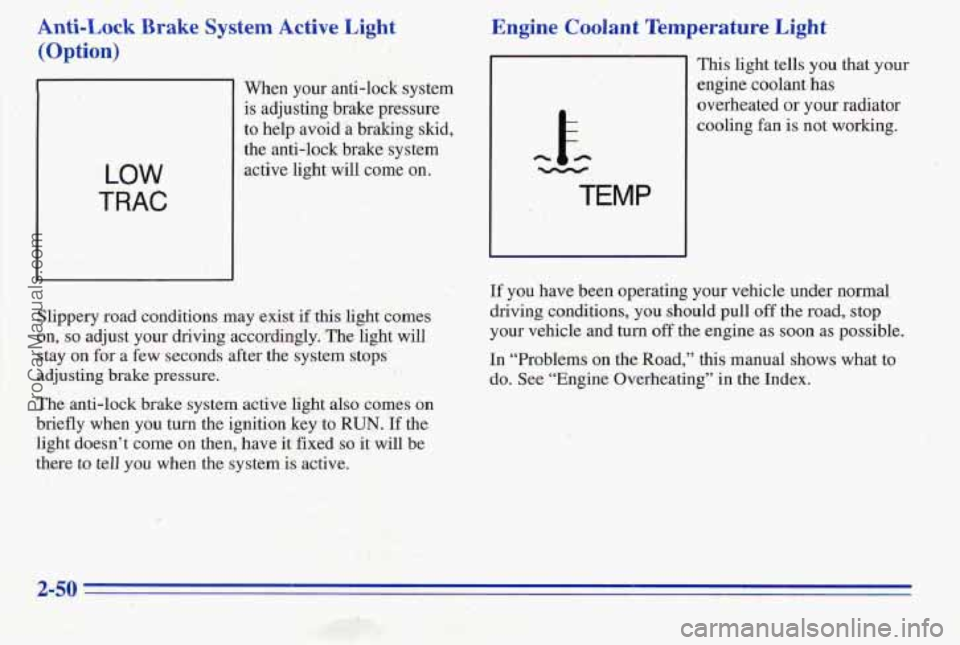
Anti-Lock Brake System Active Light
(Option)
Men your anti-lock system
is adjusting brake pressure
to help avoid a braking skid,
the anti-lock brake system
active light will come on.
Engine Coolant Temperature Light
h E- -
c. TEMP
This light tells you that your
engine coolant,
has
overheated or your radiator
c-ooling €an
is not working.
.. . ..
' .. 5
.. . .
Slippery road conditions may exist if this light comes
on,
so adjust your driving accordingly. The light will
stay un for a few seconds after the system stops
adjusting brake pressure.
If you have been operatmg your vehicle under normal
driving conditions, you should pull off the road, stop
your vehicle and turn off the engine as soon as possible.
In "Problems on the Road," this manual shows what to
do. See "Engine Overheating" in the Index.
The anti-lock brake system active light also come,s on
briefly when you turn the ignition key to RUN. If the
'light doesn't come on then, have it fixed
so it will be
there to tell you when the system is active.
ProCarManuals.com
Page 120 of 370
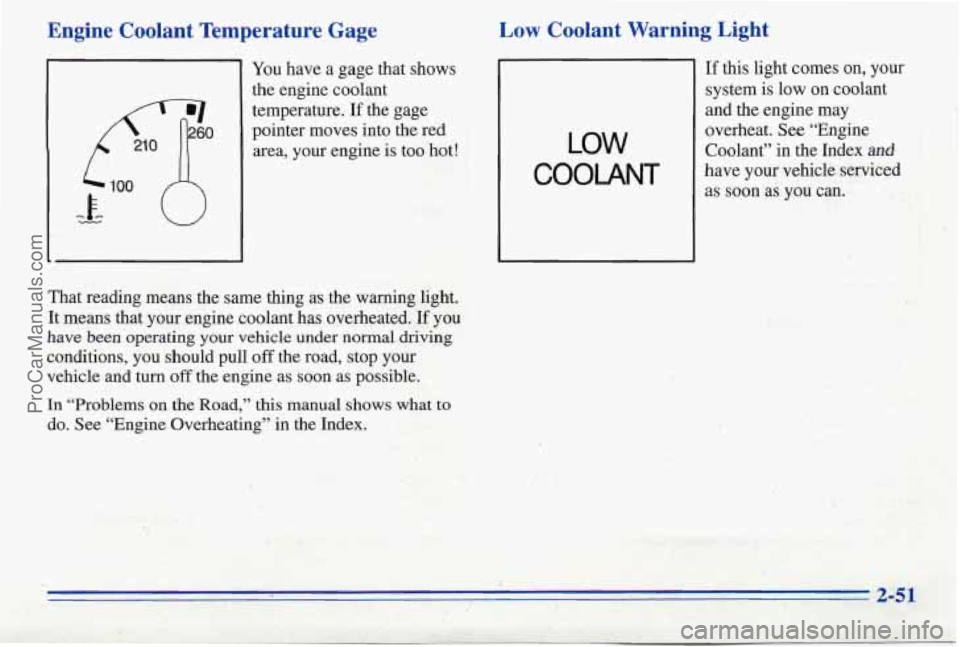
Engine Coolant Temperature Gage
You have a gage that shows
the engine coolant temperature.
If the gage
pointer moves into the red
area,
your engine is too hot!
Low Coolant Warning Light
LOW
COOLANT
If this light comes on, your
system
is low on coolant
and the engine may
overheat. See “Engine
Coolant” in the Index
and
have your vehicle serviced
as soon as you can.
That reading means the same thing as the warning light.
It means that your engine coolant has overheated.
If you
have been ‘operating your vehicle under normal driving
conditions, you should pull off the road, stop your
vehicle and turn
off the engine as soon as possible.
In “Problems on the Road,” this manual shows what to
do. S’ee “Engine Overheating” in the Index.
ProCarManuals.com
Page 191 of 370
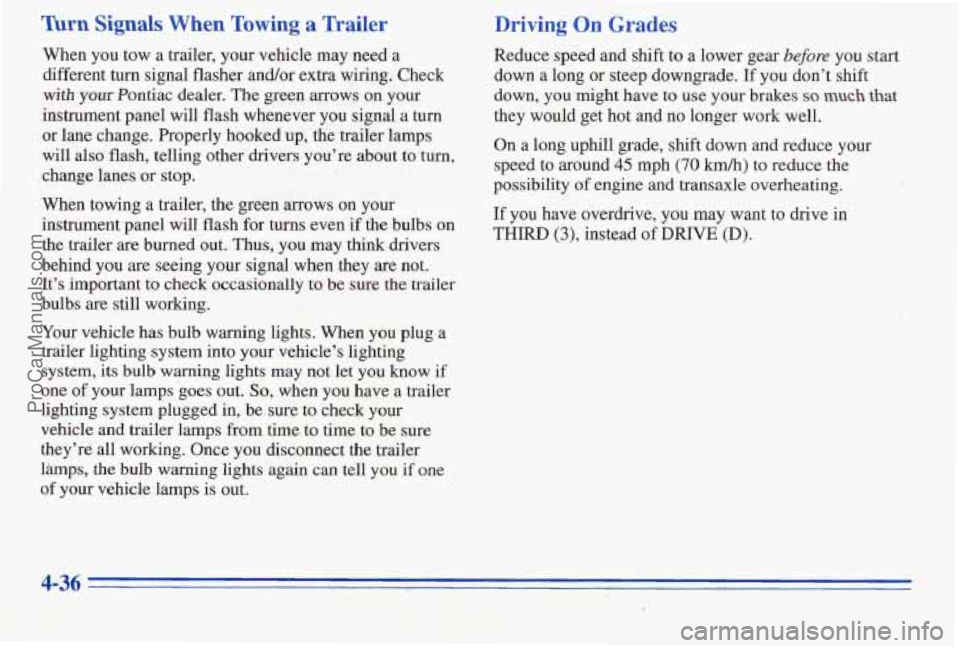
Turn Signals When Towing a Wailer
When you tow a trailer, your vehicle may need a
different turn signal flasher and/or extra wiring. Check
with your Pontiac dealer. The green arrows on your
instrument panel will
flash whenever you signal a turn
or lane change. Properly hooked up, the trailer lamps
will also flash, telling other drivers you’re about to
turn,
change lanes or stop.
When towing a trailer, the green arrows on your
instrument panel will, flash for turns even if the bulbs
on
the trailer are burned out. Thus, you may think drivers
behind you are seeing your signal when they are not.
It’s important to check occasionally
to be sure the trailer
bulbs are still working.
Your vehicle has bulb warning lights. When you plug a
trailer lighting system into your vehicle’s lighting
system, its bulb warning lights may not let you
know if
one
of your lamps goes out. So, when you have a trailer
lighting system plugged
in, be sure to check your
vehicle and trailer lamps from time to time to be
sure
they’re all working. Once you disconnect the trailer
lhmps,
the bulb warning lights again can tell you if one
of your vehicle lamps is out.
Driving On Grades
Reduce speed and shift to a lower gear before you start
down a long or steep downgrade. If you don’t shift
down, you might have to use your
brakes so much that
they wouJd get hot and no longer work well.
On a long uphill grade, shift down and reduce your
speed to around
45 mph (70 km/h) to reduce the
possibility
of engine and transaxle overheating.
If you have overdrive, you may want to drive in
THIRD (3), instead of DRIVE (D).
4-36
ProCarManuals.com
Page 205 of 370
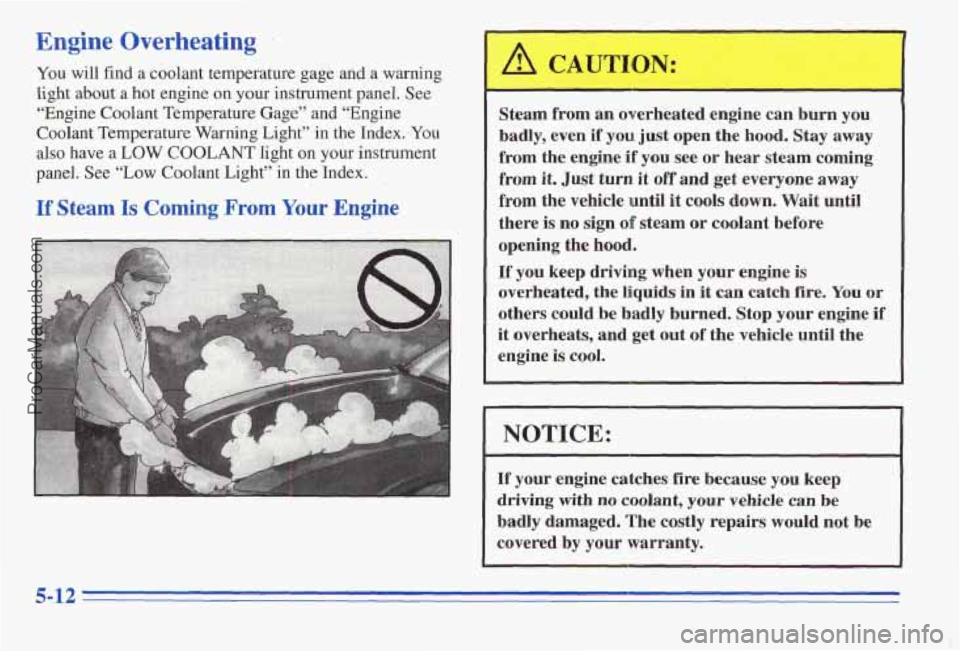
Engine Overheating
You will find a coolant temperature gage and a warning
light about a hot engine on your instrument panel. See
“Engine Coolant Temperature Gage” and “Engine
Coolant Temperature Warning Light” in the Index. You
also have
a LOW COOLANT light on your instrument
panel. See
“Low Coolant Light” in the Index.
If Steam Is Coming From Your Engine
Steam from an overheated engine can burn you
badly, even if you just open the hood. Stay away
from the engine
if you see or hear steam coming
from it. Just turn it off and get everyone away
from the vehicle until
it cools clown. Wait until
there
is no sign of steam or coolant before
opening the
hood.
If you keep driving when your engine is
overheated, the liquids in it can catch fire, You or
others could be badly burned. Stop your engine if
it overheats, and get out of the vehicle until the
engine
is cool.
I I
NOTICE:
If your engine catches fire because you keep
driving with no coolant, your vehicle can be
badly damaged. The costly repairs would not be
covered by
your warranty.
5-12
ProCarManuals.com
Page 209 of 370

A CAUTION:
I
Heater and radiator hoses, and other engine
parts,
can be very hot. Don’t touch them. If you
do, you can
be burned.
Don’t run the engine
if there is a leak. If you run
the engine,
it could lose all coolant. That could
cause
an engine fie, and you could be burned.
Get
any ‘leak fixed before you drive the, vehicle.
I NOTICE:
I
Engine damage from running your engine
without coolant isn’t covered by your warranty.
I
If there seems to be no leak, with the engine on, check to
see if the electric engine fan@) are running. If the engine
is overheating, both fan(s) should be running. If they
aren’t, your vehicle needs service.
How to Add Coolant to the Coolant
Recovery Tank
If you haven’t found a problem yet, but the coolant level
isn’t at the COLD mark, add a 50/50 mixture of ckm
water (preferably distilled) and DEX-COOL”
(orange-colored, silicate-free) antifreeze at the coolant
recovery
tank. (See “Engine Coolant” in the Index for
more information.)
Adding only plain water to your cooling system
can be
dangerous. Plain water, or some other
liquid Eke alcohol, can boil before the proper
coolant
mix will. Your vehicle’s coolant warning
system
is set for the proper coolant mix. With
plain water or the wrong mix, your engine could
get too hot but you wouldn’t get the overheat
warning.
Your engine ‘could catch fire and you or
others could be burned. Use a
50/50 mix Q€ clean
water and
DEX-COOL antifreeze.
5-16
,LC !
ProCarManuals.com
Page 247 of 370
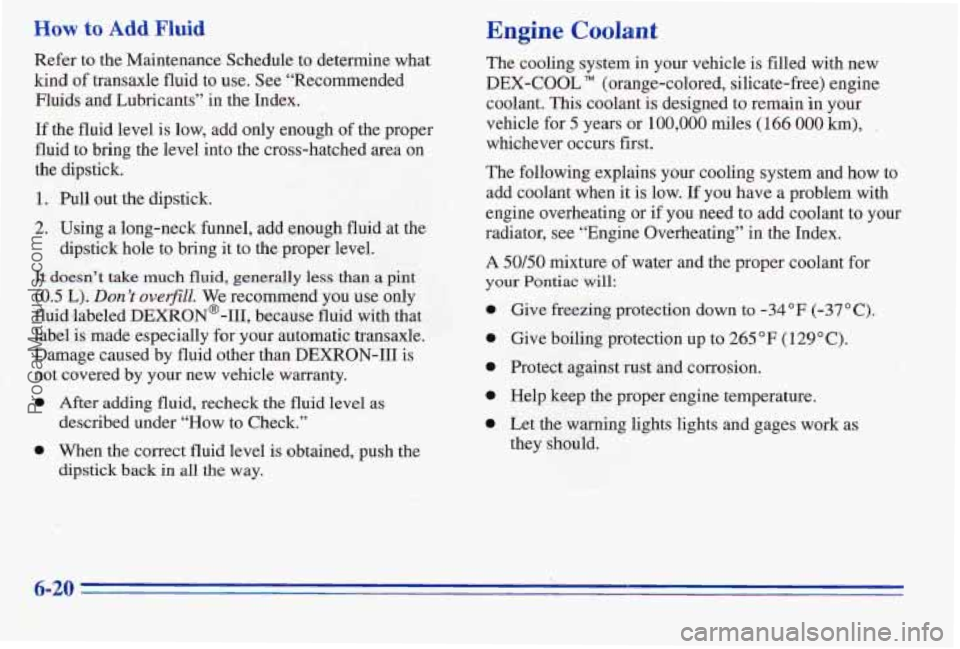
How to Add Fluid
Refer to the Maintenance Schedule to determine what
kind of transaxle fluid to use. See “Recommended
Fluids
and Lubricants” in the Index.
If the fluid level is low, add only enough of the proper
fluid to bring the level into the cross-hatched area on
the dipstick.
1. Pull out the dipstick.
2. Using a long-neck funnel, add enough fluid at the
It doesn’t take much fluid, generally less than a pint
(0.5 L). Don’t oveflll. We recommend you use only
fluid /labeled DEXRON@-HI, because fluid with that
label
is made especially for your automatic transaxle.
Damage caused by fluid other than
DEXRON-111 is
not covered by your new vehicle warranty.
0 After adding fluid, recheck the fluid level as
0 When the correct fluid level is obtained, push the
dipstick hole to bring
it to the
proper level.
described under “How to Check.”
dipstick
back in all the way.
Engine Coolant
The cooling system in your vehicle is filled with new
DEX-COOL (orange-colored, silicate-free) engine
coolant. This coolant is designed
to remain in your
vehicle for 5 years or 100,000 miles (166 000 km), ,
whichever occurs first.
The following explains your cooling system and how to
add coolant when it is low.
If you have a problem with
engine overheating or
if you need to add coolant to your
radiator, see “Engine Overheating” in the Index.
A 50/50 mixture of water and the proper coolant for
your Pontiac will:
0
0
0
0
0
Give freezing protection down to -34°F (-37°C).
Give boiling protection up to 265 “F (129°C).
Protect against rust
and corrosion.
Help keep the proper engine temperature.
Let the warning lights lights and gages work as
they should.
ProCarManuals.com
Page 250 of 370
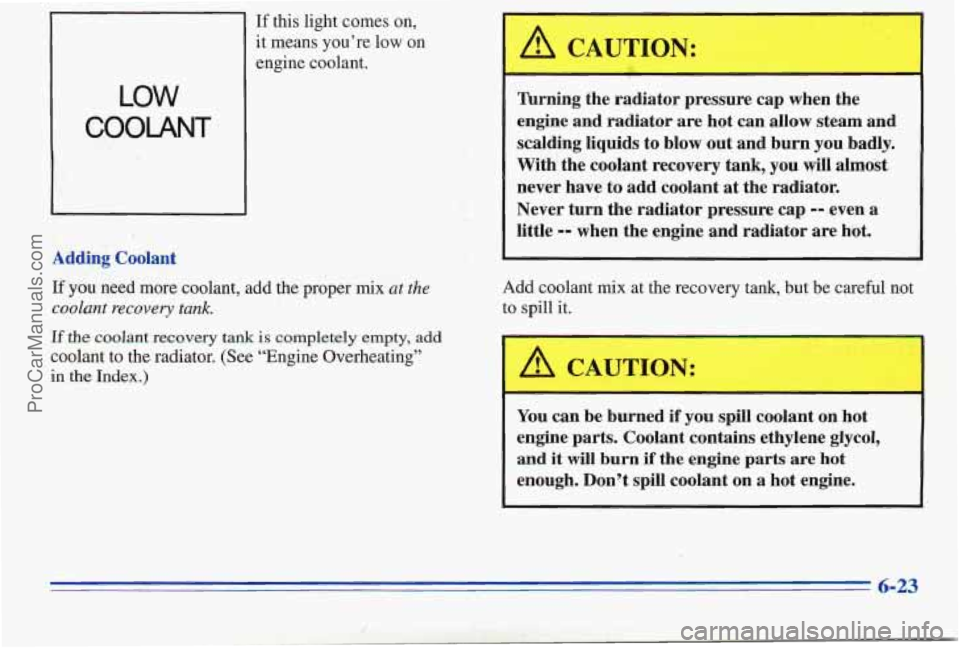
If this light comes on,
it means you’re low on
engine coolant.
LOW
COOLANT
L
Adding Coolant
A CAUTION:
lhrning the radiator pressure cap when the
engine and radiator are hot can allow steam and
scalding liquids to blow out and burn you badly.
With the coolant recovery tank, you will almost
never have.to add coolant
at the radiator.
Never turn the radiator pressure cap
-- even a
little -- when the engine and radiator are hot.
If you need more coolant, add the proper mix at the Add
coolant mix at the recovery tank, but be careful not
coolant recovery tank. to
spill it.
If the coolant recovery tank is completely empty, add
coolant to the radiator. (See “Engine Overheating”
in the Index.) ’ A CAUTION:
You can be burned if you spill coolant on hot
engine parts. Coolant contains ethylene glycol,
and it
will burn if the engine parts are hot
, enough. Don’t spill coolant on a hot engine.
ProCarManuals.com
Page 251 of 370
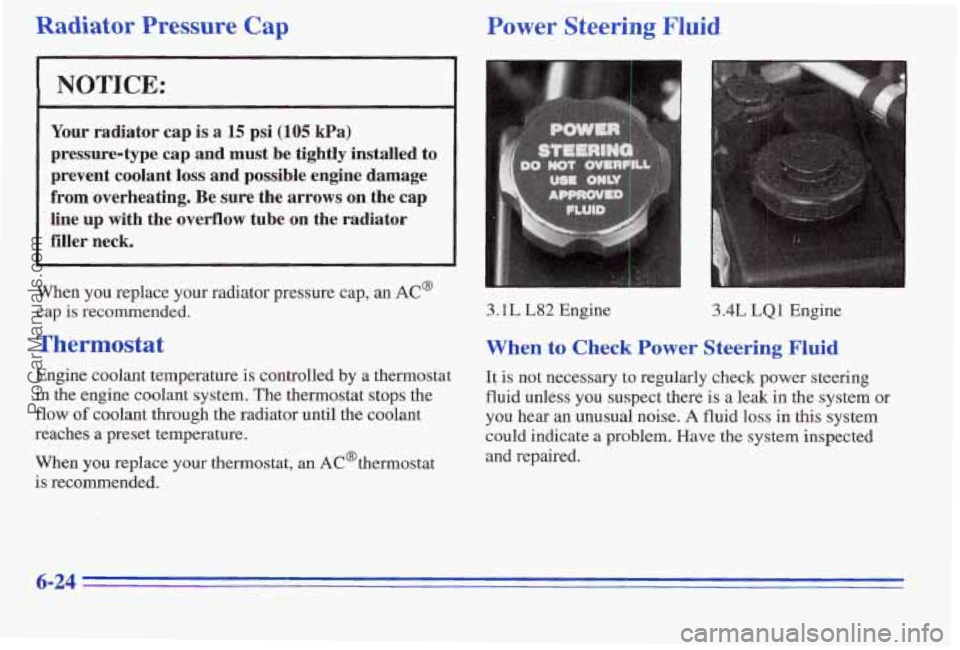
Radiator Pressure Cap Power Steering Fluid
NOTICE:
Your radiator cap is a 15 psi (105 kPa)
pressure-type cap and must
be tightly installed to
prevent coolant loss and possible engine damage
from overheating.
Be sure the arrows on the cap
line up with the overflow.tube on the radiator
filler neck.
When you replace your radiator pressure cap, an AC@
cap is recommended.
Thermostat
Engine coolant temperature is controlled by a thermostat
in the engine coolant system. The thermostat stops the
flow
of coolant through the radiator until the coolant
reaches a preset temperature.
When you replace your thermostat,
an AC'thermostat
is recommended.
3.1L L82 Engine 3.4L LQ1 Engine
When to Check Power Steering Fluid
It is not necessary to regularly check power steering
fluid unless
you suspect there is a leak in the system or
you hear an unusual noise.
A fluid loss in this system
could indicate
a problem. Have the system inspected
and repaired.
6-24 -
ProCarManuals.com